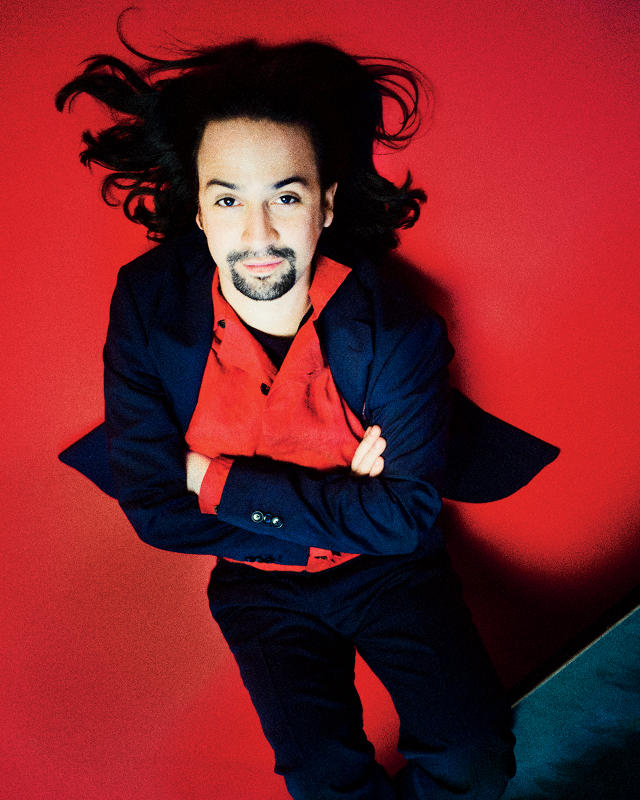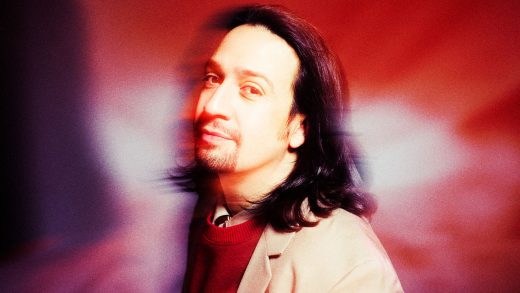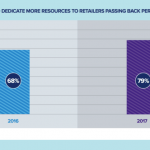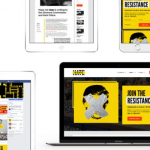How “Hamilton” Creator Lin-Manuel Miranda Is Building A Brand For The Ages
If you ever find yourself in a position to sit down with Lin-Manuel Miranda, know this: You never really “sit down” with Lin-Manuel Miranda. He is always in motion, on a mission; standing still really isn’t his thing. When the 36-year-old composer and lyricist was dreaming up the songs for Hamilton, the Broadway phenomenon that he wrote every line of and currently stars in eight times a week, he would often walk for hours through the streets of New York City, willing the words to come. Even now, he insists that the calmest he ever feels is during the 2 hours and 45 minutes of the show, when he gets to bound around onstage as Alexander Hamilton, “yelling and rapping at the top of my lungs. It’s the most relaxing part of my day.” The physical exertion returns him, every night, to himself, offering an unlikely respite from the attention that’s swirled around him since Hamilton became a cultural and financial force. The only way that Miranda stays whole, now that everyone wants to engage with him—Hollywood, the White House, hundreds of thousands of Twitter followers, the music industry, Broadway obsessives, big-money investors, American history buffs, prize committees, schoolteachers, the political establishment—is to keep moving.
On a windy night in March, he invites me to hop with him into the backseat of a black SUV to go from the northernmost tip of Manhattan, where he lives, across the George Washington Bridge into New Jersey. (“This is Chris’s bridge!” he says proudly as we glide over it, a shout-out to his longtime friend Christopher Jackson, who plays America’s first president in Hamilton.) Miranda rarely finds time to sleep, let alone cross state lines on his night off, but tonight, he tells me with a grin, he is headed to the town of Montclair on a matter of family justice: He needs to settle a score among some fourth graders. One of them has been going around telling his classmates that his uncle is the Hamilton in Hamilton, creator of the cultural juggernaut that recently won the Pulitzer Prize for Drama. This is true. But 10-year-olds are skeptics; they require physical proof. So Miranda is making a special appearance in the auditorium of the stately Montclair Kimberley Academy, where he will, as he puts it delicately, “rub it in all those kids’ faces. This is in my job description as cool uncle. And if I can’t use my powers for that, what am I even doing?”
Related Video: Inside The Mind Of “Hamilton” Creator Lin-Manuel Miranda
Hamilton, which opened at New York’s Richard Rodgers Theatre in August 2015, after an off-Broadway run, isn’t just a hit musical. It’s one of those rare cultural phenomena that reaches beyond its genre and infiltrates the broader conversation. Fourth graders love the show as much as 80-year-olds. Hip-hop fans and history buffs alike are giddy over its inspirational, intricately rhymed retelling of the founding father’s complicated relationships with Aaron Burr, George Washington, Thomas Jefferson, and more. President Obama is a fan, and a parade of celebrities have streamed through, including Oprah Winfrey (“Wow! Wow! Wow!” she wrote on Instagram) and Paul McCartney. Tickets to the production, which recently nabbed a record 16 Tony nominations, are more or less impossible to acquire, unless you’re willing to drop as much as $3,000 on the resale market. Which is probably why the cast recording was the Billboard album chart’s highest-debuting cast recording in 50 years. “Yes,” wrote New York Times theater critic Ben Brantley in an unqualified rave, “it really is that good.”
When Miranda speaks about his current cultural influence, which he does often, with phrases like “all eyes on me,” and “the world is calling”—he does so matter-of-factly. He knows that there’s no use being coy about what has become undeniable: He is the most powerful person working on Broadway today and a galvanizing figure in music, publishing, and film, as well. He is grateful to hold this title, grateful to be living out “the timeline where it all went right. There are many other timelines that could have been,” he says. “But this is what happened, and I am aware there is a giant spotlight on me.”
Here’s where that path became interesting: After winning a 2008 Tony for his first musical, In the Heights, which used Latin rhythms and syncopated lyrics to capture life in Washington Heights, the northern Manhattan neighborhood adjacent to where Miranda grew up, the playwright received an invitation to perform at the White House as part of an evening of poetry and spoken word. The organizers told him that he could do a number from In the Heights, but he had another idea. On a recent vacation in Mexico, he had read Ron Chernow’s 800-page biography of Alexander Hamilton, which he says he’d found while strolling through a bookstore. “I just felt like I knew him,” he says of the scrappy, ambitious immigrant who went on to create America’s financial backbone. The idea hit him like a sickness: a way to relate Alexander Hamilton’s life to a modern audience. “I knew that the only way to tell his story was in the language of hip-hop.”
So he decided to try out this approach—in front of the president and First Lady. At first, Miranda had been thinking of Hamilton as a concept album, a rap symphony about the founding fathers and their dreams of rebellion, freedom, and moguldom. When he told the crowd at the White House that he was working on this project, everyone giggled, including the Obamas—it seemed like a lark. But then he launched into verse: “How does a bastard, orphan, son of a whore and a / Scotsman, dropped in the middle of a forgotten / Spot in the Caribbean by Providence, impoverished, in squalor / Grow up to be a hero and a scholar?”
Suddenly, no one was laughing. A video of Miranda’s D.C. triumph went viral, and soon, he had gotten a reported $175,000 advance to convert his idea into a full-blown stage show at the downtown Public Theater alongside his Heights collaborators: director Thomas Kail, music director Alex Lacamoire, and choreographer Andy Blankenbuehler. He merged a historical story (the rise and fall of a founding father) and classic medium (stage) with today’s vernacular and rhythms (rap, R&B, pop) and a cast that reflects contemporary America (the actors playing Washington, Burr, Jefferson, Madison—plus Hamilton’s wife, Eliza Schuyler, and her two sisters—are all people of color). He merged the country’s raucous, inspiring past with its vibrant, volatile present, offering both an elegy for where we have been and a beacon for where we might go next. Oskar Eustis, the artistic director of the Public, knew from his first glimpse at a video of the White House performance that Miranda’s musical would be unstoppable. It gave people “a way to feel unabashedly patriotic about America,” he says. It was something around which an increasingly divided nation might come together. And they have.
After six years of development, the show debuted downtown in January 2015 to sold-out crowds and then opened at Broadway’s Richard Rodgers Theatre that August, with tickets immediately selling out again. While the musical was still in previews, the theater continued a tradition started at the Public of holding a lottery outside the box office each day for nearly two dozen $10 front-row seats to that night’s show. It became known as #Ham4Ham. The lottery went online over the winter, because the crowds had simply become too large to manage. (At Christmastime, more than a thousand people were showing up each day and blocking traffic. “We had no permits for that kind of thing,” says Miranda. “It just sort of happened. I wasn’t interested in all those fans freezing.”) In March, a fan developed the Ham Lottery App to make the process even more user-friendly. Today, the face-value price of a premium Hamilton ticket, should you manage to snag one this decade (and good luck), is $549 and rising. Resale prices are routinely more than triple that.
The show has already exceeded producers’ expectations. According to figures obtained by the Hollywood Reporter and the New York Times, Hamilton averages more than $500,000 in profit every week and made more than $60 million total at the box office in less than eight months. Investors, who sunk $12.5 million into the production, have already recouped their seed money, a rare feat for any Broadway show. Miranda, as Hamilton’s sole progenitor, reportedly makes 7% in royalties and earns about $105,000 per week from the box-office take alone.
There are softer metrics too. Miranda has become the one famous person whom every other famous person wants to know. Hamilton fans check Twitter every night to see which new celebrity has posted a photo with the star: Kanye West, Julia Roberts, Beyoncé, Madonna, Nas, Eminem, Amy Schumer, Kerry Washington, and Julie Andrews have all sat in the red velvet seats to catch a glimpse of Miranda and crew firing cannons and rapping about the Battle of Yorktown. “I mean, it’s insane,” Miranda says. “I could go to an invited thing every night and become this crazy celebrity person if I wanted to.” But, he adds, “I can’t, because I still have a show to do.”
A ticket to Hamilton has also become a status symbol in Washington, D.C. Madeleine Albright, the Clintons, Bernie Sanders, Timothy Geithner, Dick Cheney, and the Bush sisters have all attended the show. President Obama has seen it, and arranged for the entire cast to perform at the White House last March, where he also taped a segment with Miranda for an upcoming PBS documentary about the musical. (Obama often quips that Hamilton is “the only thing Dick Cheney and I can agree on.”)
But Miranda’s closest—and most important—relationship is with the hundreds of thousands of fans who have likely never seen the show. Ticket scarcity has motivated him to create an entire world around it, so that people, and especially young people, can feel like a part of the movement even if they can’t get into the theater. This strategy began with the cast album, which Miranda and Lacamoire released only six weeks after Hamilton opened on Broadway, hiring Roots bandleaders Questlove and Black Thought to engineer the sound so that it would satisfy even the most critical ears (“Hip-hop fans are the toughest fans,” Miranda says. “You win them, you win them for life”). The album won a Grammy in February and went gold in April; it’s been streamed on Spotify more than 148 million times and has given the entire world a portal into Miranda’s dense lyrical accomplishment, something to geek out over and memorize the way Miranda, as a teen, internalized Biggie Smalls, Busta Rhymes, Nas, and the Wu-Tang Clan. In November, Miranda himself wrote 23 annotations to the show’s lyrics on the website Genius, enhancing the fan experience even further. “With the album, for $20, you have the whole show. You can get it on your phone,” says Kail, Hamilton’s director. “I know how much money Star Wars made, so I know everybody has $20.” A hulking coffee-table book about the making of the musical, called Hamilton: The Revolution, went on sale in April. The PBS documentary, which Miranda has been filming with his friend Alex Horowitz since he first had the idea for the show seven years ago, will air this fall. A Questlove and Black Thought–produced Hamilton Mixtape is also due this fall, from Atlantic Records, featuring such artists as Busta Rhymes, Ben Folds, Regina Spektor, and Common.
All of this brings Miranda close to his fans, and Twitter brings him even closer. Miranda admits he has a low-level addiction to the service. (The day we went to New Jersey, he had attempted to take the day off but had already tweeted five times: “I had to!” he says. “Weird Al made a Hamilton reference on a marquee, and Weird Al is my hero.”) He is an expert at starting memes and using hashtags to make his 350,000 followers feel included in a secret world where those who “really get” Hamilton go to hang out. One of his most effective has been the #Ham4Ham series of short performances and videos he launched unexpectedly during the live lottery one day last summer as a way to keep sweltering fans in the heat from getting enraged. “Seven hundred people showed up, and that was insane,” he says. “I went outside, I got up in front of them, unplanned, and said, ‘Thank you all! I love you. You won’t all win, but come back! Here’s a thing we can give you in gratitude. We will be here if you keep showing up.’ ”
Miranda kept his word, and within weeks the increasingly elaborate #Ham4Ham performances became a must-see live event of their own. Miranda brought out members of the cast to do offbeat sketches (such as gender-swapped musical numbers), invited performers from other Broadway shows to sing and perform, and judged rap battles between fans. After the lottery moved online, #Ham4Ham became a YouTube series, showing backstage videos and insider footage. When the cast went to the White House last March, Miranda filmed three #Ham4Ham videos in a single day, taking over various parts of the building to do so. “We were shooting in every nook and cranny of the place,” he says.
Miranda has cultivated—and maintained—a level of devotion among his followers that branding agencies only dream of. He insists that there is no gimmick to it, just a raw desire to connect to other rap, theater, and history nerds. “I hate the word branding,” he says. “I don’t feel like an entrepreneur. I feel like a writer who is forced to wear an entrepreneurial hat occasionally.” To balance out the actual branding campaigns that are trying to capitalize on the #Hamilton movement (there are Hamilton SoulCycle classes, unofficial Hamilton tours, Hamilton-themed cocktails in Manhattan bars), Miranda solicits fan art and wordplay, responds to questions online, and speaks to his followers with the intimacy of a friend. In the run-up to the release of Hamilton: The Revolution, which contains the show’s full libretto, photos, behind-the-scenes anecdotes, and more (aka #Hamiltome), Miranda asked his followers to vote on which passages they’d like him to leak. Hamilton, the stage show, may be a work only a few have access to, but Miranda has created an equally special club for everyone else.

As we pull up to the sprawling, white-stucco Montclair Kimberley Academy, car traffic is so backed up, due to Miranda’s imminent appearance, that we can’t get anywhere near the circular driveway that leads to the main entrance. So the driver reverses and takes us around back, giving us a full view of the line of parents and kids waiting to get through the door, which extends literally around the block. Teenagers at the event tell me later that they waited five hours to get in; many came from neighboring schools. A young woman, a member of the a cappella group the Unaccompanied Minors, who sang a Hamilton medley to welcome Miranda to the stage, tells me that she is applying to drama school because of him. “He is, like, such an inspiration.”
Miranda likes this part of his job. “It’s easier for me to talk to kids than adults, by a lot,” he says. After graduating from Wesleyan (where he’d already started creating In the Heights), Miranda spent a year as a seventh-grade English teacher in Manhattan, and he remains committed to education. Last year, Jim Basker, head of the Gilder Lehrman Institute for American History, approached the Hamilton creators about starting a curriculum initiative, backed by the Rockefeller Foundation. This spring, the Hamilton Education Program is helping 20,000 11th graders in New York City public schools learn American history through a series of videos and study guides that Miranda helped develop. Participating students write and perform their own musical projects based on historical documents and research. They will also get to see Hamilton. Thanks to a $1.5 million grant from Rockefeller, within the next year, 20,000 youngsters will get to attend special, student-only showings on Wednesday afternoons for only $10. “They have to pay a Hamilton,” says Basker. “We wanted them to understand, as they learn from watching Alexander Hamilton, that you have to have financial skin in the game.” Before each show, a group of students selected by the institute will get to perform their classroom theater pieces in front of Miranda and other Hamilton cast members, receiving a live master class.
Miranda says that the joy of having Hamilton succeed is being able to divert attention toward issues he cares about. When the cast went to the White House in March, he stayed on for a day and “lobbied Congress on behalf of Puerto Rico and its debt crisis. That is something that is very important to me,” says Miranda, who is the son of Puerto Rican immigrants. He has also used the popularity of the show to help raise money for Graham Windham, the orphanage that Eliza Hamilton started and that is sung about in the show’s closing number. The organization “has raised an unprecedented amount” since the musical opened, he says.
The next time I see Miranda, it’s over lunch inside an industrial-loft studio in Chelsea a few weeks later as he’s catching a breath between publicity photo shoots. He has just returned from the White House, and tells me about a moment he will never forget. “It will be the thing I tell my great-grandkids, if I get to live that long,” he says. Miranda watched Christopher Jackson, the show’s George Washington, deliver the first president’s farewell address as the sitting president looked on, tears rolling down Obama’s face. After the performance—Miranda had intentionally staged the number under Washington’s portrait—Obama gave some impromptu remarks. “He looked over at me,” Miranda says, getting misty. “And he said, ‘Thanks for showing us how to say goodbye.’ ”
Miranda, too, is contemplating a departure. He acknowledges that he cannot portray Hamilton onstage forever, and other projects are beginning to vie for his attention. In addition to launching new Hamilton productions (Chicago in September 2016; Los Angeles in 2017; and a touring company, starting in San Francisco, also in 2017), Miranda has been moonlighting for Disney, writing the lyrics and music for its next animated feature, the South Pacific–set Moana, due in theaters November 23. Miranda, ever the populist, says that writing for Disney has always been one of his goals. “The Little Mermaid is the reason I’m talking to you,” he says, in all seriousness. “When that calypso music started playing, it was the first time I truly felt transported by a piece of art.” He is then likely to continue his relationship with Disney as a live-action movie star. Director Rob Marshall (Chicago) says that he has written a role for Miranda in his new adaptation of Mary Poppins. “He’s playing a lamp lighter in the 1930s,” says Marshall, “part Dick Van Dyke and part man of the streets. It felt like the perfect fit.”
As for a much-rumored Hamilton film, Miranda says he won’t be making one anytime soon. “I am absolutely interested in as many people seeing this as possible,” he says. “But not before people have had the opportunity to see it live.” There is no doubt that Hamilton will continue to run on Broadway for the foreseeable future (even after he is no longer onstage every night), sparking ongoing dialogue among viewers about what it means to live in America. It will continue reflecting both our present and our complicated past. As Miranda notes, “The Constitution was a giant f—king compromise. Black people were three-fifths of a human, and women aren’t mentioned in it. We set [the production] in a world where not everyone is equal. And we are still in a world where not everyone is equal. Despite the various hues of our cast, we never pretend otherwise.” Still, the show allows audiences to dream of a nation where change can happen. “Government’s going to expand and contract based on who’s in charge,” he says. “And that gives me hope, in a weird way. To know that we did not create these problems, that they are contradictions that are essential to who we are. We always fall short. But the ideals are worth fighting for.”
A version of this article appeared in the June 2016 issue of Fast Company magazine.
Fast Company , Read Full Story
(102)














